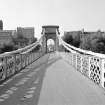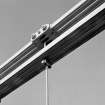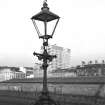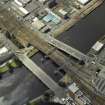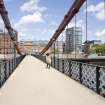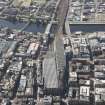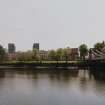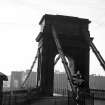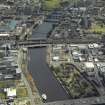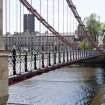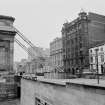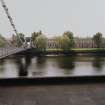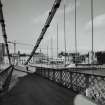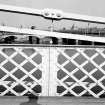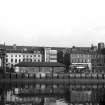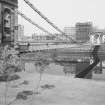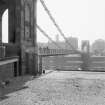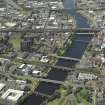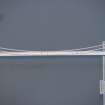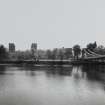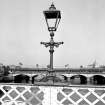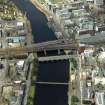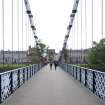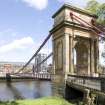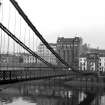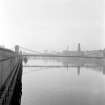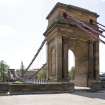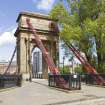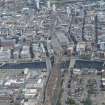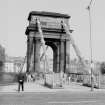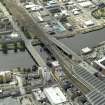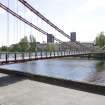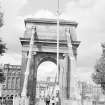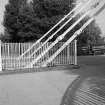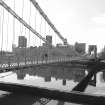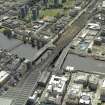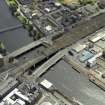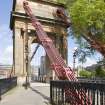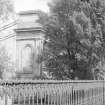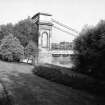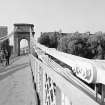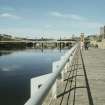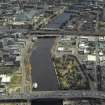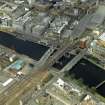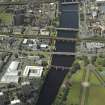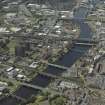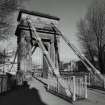Following the launch of trove.scot in February 2025 we are now planning the retiral of some of our webservices. Canmore will be switched off on 24th June 2025. Information about the closure can be found on the HES website: Retiral of HES web services | Historic Environment Scotland
Glasgow, Upper Harbour, South Portland Street Suspension Footbridge
Suspension Bridge (19th Century)
Site Name Glasgow, Upper Harbour, South Portland Street Suspension Footbridge
Classification Suspension Bridge (19th Century)
Alternative Name(s) River Clyde; Portland Street Suspension Bridge; Carlton Place; Clyde Street Suspension Bridge; Custom House Quay
Canmore ID 44349
Site Number NS56SE 83
NGR NS 58907 64723
Datum OSGB36 - NGR
Permalink http://canmore.org.uk/site/44349
- Council Glasgow, City Of
- Parish Glasgow (City Of Glasgow)
- Former Region Strathclyde
- Former District City Of Glasgow
- Former County Lanarkshire
NS56SE 83 58907 64723
Suspension Bridge [NAT]
OS 1:1250 map, 1967.
For predecessor bridge (in same location), see NS56SE 2160.
Location formerly entered as from NS 5888 6466 to NS 5893 6478.
Portland Street Suspension Footbridge, built 1851 by the Heritors of Gorbals, and reconstructed 1871. The Classical pylons were designed by A Kirkland, architect, and the metalwork by George Martin, engineer. The light lattice girder deck is suspended from flat link chains and the clear span is 414ft (126.2m). The bridge retains its gas lampholders, now electrified. SDD category A.
J R Hume 1974.
(Suspension bridge of Samual Brown flat link type). Built 1851, rebuilt 1871. Alexander Kirkland, architect (masonry), George Martin, engineer (ironwork). Classical masonry pylons, single flat-link chains (5 links wide) on each side, iron rod suspenders, light lattice-girder deck. Span 414 ft (126.2m). Public footbridge.
J R Hume 1977b.
South Portland Street Footbridge, 1851-3. A wrought iron suspension bridge, the ironwork designed by George Martin, engineer, and the supporting stone pylons by Alexander Kirkland, architect. It was erected at the expense of the heritors of Gorbals to replace a wooden (NS56SE 2160) bridge near the same spot which had been built for temporary use while the [old] Broomielaw Bridge (NS56SE 2159) was rebuilding in 1833-5, but was much used until it became unsafe in 1846. In 1870-1 Bell and Miller, engineers, altered the ironwork, lowering the main chains and deck at midspan, and adding lattice girders to the side-rails. There were further repairs to the deck and side-rails in 1926.
The fine profile should be seen against the sky, not, as it appears from most viewpoints, with a background of buildings. The pylons, of yellow-brown sandstone, are triumphal arches of Grecian construction, with square pilasters at the outer corners, pairs of fluted Ionic columns flanking the entries, and over the entablatures massive ashlar plinths through which the chains pass to rest on their saddle supports. There are two chains on each side of the bridge, each chain link being five flat wrought iron bars; wrought iron suspenders at about 1.5m (5ft) spacing; and a deck of wrought iron or steel cross beams and wooden floor.
E Williamson, A Riches and M Higgs 1990.
This footbridge crosses the River Clyde within the area of the Upper Harbour, between Custom House Quay (to the N) and Carlton Place (to the S). The river here forms the boundary between the parishes of Glasgow (to the N) and Govan (to the S).
The location assigned to this record defines the centre of the span. The available map evidence suggests that it extends from NS 58941 64795 to NS 58871 64647.
Information from RCAHMS (RJCM), 19 December 2005.
REFERENCE:
Civil Engineer George Martin
Opened 18.5.1853
REFERENCE:
J G Dunbar vol 1 p236 Sept 1 1855 Building Chronicle - Text
REFERENCE:
Mitchell Library
Glasgow in Former Times c.1850 - Ink sketch
(Undated) information in NMRS.
Construction (1853)
Replaced earlier timber Robert Stevenson designed bridge of 1832.
Modification (1870 - 2004)
Bridge modified: 1870-1 (Bell and Miller, ironwork reconstructed); 1898; 1926 (refurbishment, Sir William Arrol); 1996; 2004. By 2004, all hangers replaced and main chains strengthened at anchorages.
Project (2007)
This project was undertaken to input site information listed in 'Civil engineering heritage: Scotland - Lowlands and Borders' by R Paxton and J Shipway, 2007.
Publication Account (2007)
Portland Street Suspension Footbridge has a suspension span of 414 ft and Greek-style towers in the form of triumphal arches. This bridge, designed by A. Kirkland, architect and G. Martin, engineer, has a claim to being Glasgow’s most elegant bridge. It was opened in 1853, replacing a state-of-the-art 14-span timber bridge
designed by Robert Stevenson and built by William Robertson in 1832 to accommodate traffic during the building of the Broomielaw Bridge and retained for pedestrian use until 1846. James Walker submitted designs for suspension and iron arch bridge replacement footbridges neither of which was implemented.
The suspension bridge deck is 13 ft wide and supported by four eye-bar link chains with 10 ft long links. The dip of the chains is about 26 ft, giving a dip-to-span ratio of 1 to 16. In 1870–71 the ironwork underwent reconstruction under the direction of Bell & Miller at a cost of £6836. The contractors were Hanna, Donald & Wilson, Paisley.
Further refurbishment was carried out in 1898, 1926 (Sir W. Arrol, cost £4400), 1996 and 2004, by which time all the hangers had been replaced and the main chains had been strengthened at the anchorages. A 5m long Arrol hanger is preserved at the Institution of Civil Engineers Museum at Heriot-Watt University.
R Paxton and J Shipway 2007
Reproduced from 'Civil Engineering heritage: Scotland - Lowlands and Borders' with kind permission of Thomas Telford Publishers.




























































